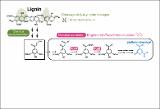Files in this item
Discovery of novel enzyme genes involved in the conversion of an arylglycerol-β-aryl ether metabolite and their use in generating a metabolic pathway for lignin valorization
Item metadata
| dc.contributor.author | Higuchi, Yudai | |
| dc.contributor.author | Kato, Ryo | |
| dc.contributor.author | Tsubota, Koichiro | |
| dc.contributor.author | Kamimura, Naofumi | |
| dc.contributor.author | Westwood, Nicholas J. | |
| dc.contributor.author | Masai, Eiji | |
| dc.date.accessioned | 2020-08-03T23:34:11Z | |
| dc.date.available | 2020-08-03T23:34:11Z | |
| dc.date.issued | 2019-09 | |
| dc.identifier | 260439900 | |
| dc.identifier | 65cba857-2db5-40d2-85fe-7dee252d0ea0 | |
| dc.identifier | 85070291860 | |
| dc.identifier | 000482582100027 | |
| dc.identifier.citation | Higuchi , Y , Kato , R , Tsubota , K , Kamimura , N , Westwood , N J & Masai , E 2019 , ' Discovery of novel enzyme genes involved in the conversion of an arylglycerol-β-aryl ether metabolite and their use in generating a metabolic pathway for lignin valorization ' , Metabolic Engineering , vol. 55 , pp. 258-267 . https://doi.org/10.1016/j.ymben.2019.08.002 | en |
| dc.identifier.issn | 1096-7176 | |
| dc.identifier.other | RIS: urn:35B26178F4C028E6BE5A37D784817968 | |
| dc.identifier.other | ORCID: /0000-0003-0630-0138/work/60426753 | |
| dc.identifier.uri | https://hdl.handle.net/10023/20402 | |
| dc.description.abstract | Microbial conversions known as “biological funneling” have attracted attention for their ability to upgrade heterogeneous mixtures of low-molecular-weight aromatic compounds obtained by chemical lignin depolymerization. β-hydroxypropiovanillone (HPV) and its analogs can be obtained by chemoselective catalytic oxidation of lignin using 2,3-dichloro-5,6-dicyano-1,4-benzoquinone/tert-butyl nitrite/O2, followed by cleavage of arylglycerol-β-aryl ether with zinc. Sphingobium sp. strain SYK-6 can degrade HPV generated by the catabolism of arylglycerol-β-aryl ether through 2-pyrone-4,6-dicarboxylate (PDC), a promising platform chemical. Therefore, production of PDC from HPV can be achieved using the HPV catabolic pathway. However, the pathway and genes involved in the catabolism of vanilloyl acetic acid (VAA) generated during HPV catabolism have not been investigated. In the present study, we isolated SLG_24960 (vceA), which encodes an enzyme that converts VAA into a coenzyme A (CoA) derivative of vanillate (vanilloyl-CoA) from SYK-6, by shotgun cloning. The analysis of a vceA mutant indicated that this gene is not required for VAA conversion in vivo, but it encodes a major enzyme catalyzing CoA-dependent VAA conversion in vitro. We also identified SLG_12450 (vceB), whose product can convert vanilloyl-CoA to vanillate. Enzyme genes besides vceA and vceB, which are necessary for the conversions of HPV to VAA and of vanillate to PDC, were introduced and expressed in Pseudomonas putida. The resulting engineered strain completely converted 1 mM HPV into PDC after 24 h. Our results suggest that the enzyme genes that are not required for the catabolic pathway in microorganisms but can be used for the conversion of target substrates are buried in microbial genomes. These genes are, thus, useful for designing metabolic pathways to produce value-added metabolites. | |
| dc.format.extent | 23256645 | |
| dc.language.iso | eng | |
| dc.relation.ispartof | Metabolic Engineering | en |
| dc.subject | Sphingobium sp. SYK-6 | en |
| dc.subject | Lignin | en |
| dc.subject | β-aryl ether | en |
| dc.subject | 2-Pyrone-4,6-dicarboxylate | en |
| dc.subject | β-keto acid cleavage enzyme | en |
| dc.subject | QD Chemistry | en |
| dc.subject | NDAS | en |
| dc.subject.lcc | QD | en |
| dc.title | Discovery of novel enzyme genes involved in the conversion of an arylglycerol-β-aryl ether metabolite and their use in generating a metabolic pathway for lignin valorization | en |
| dc.type | Journal article | en |
| dc.contributor.institution | University of St Andrews. School of Chemistry | en |
| dc.contributor.institution | University of St Andrews. Biomedical Sciences Research Complex | en |
| dc.contributor.institution | University of St Andrews. EaSTCHEM | en |
| dc.identifier.doi | https://doi.org/10.1016/j.ymben.2019.08.002 | |
| dc.description.status | Peer reviewed | en |
| dc.date.embargoedUntil | 2020-08-04 |
This item appears in the following Collection(s)
Items in the St Andrews Research Repository are protected by copyright, with all rights reserved, unless otherwise indicated.

